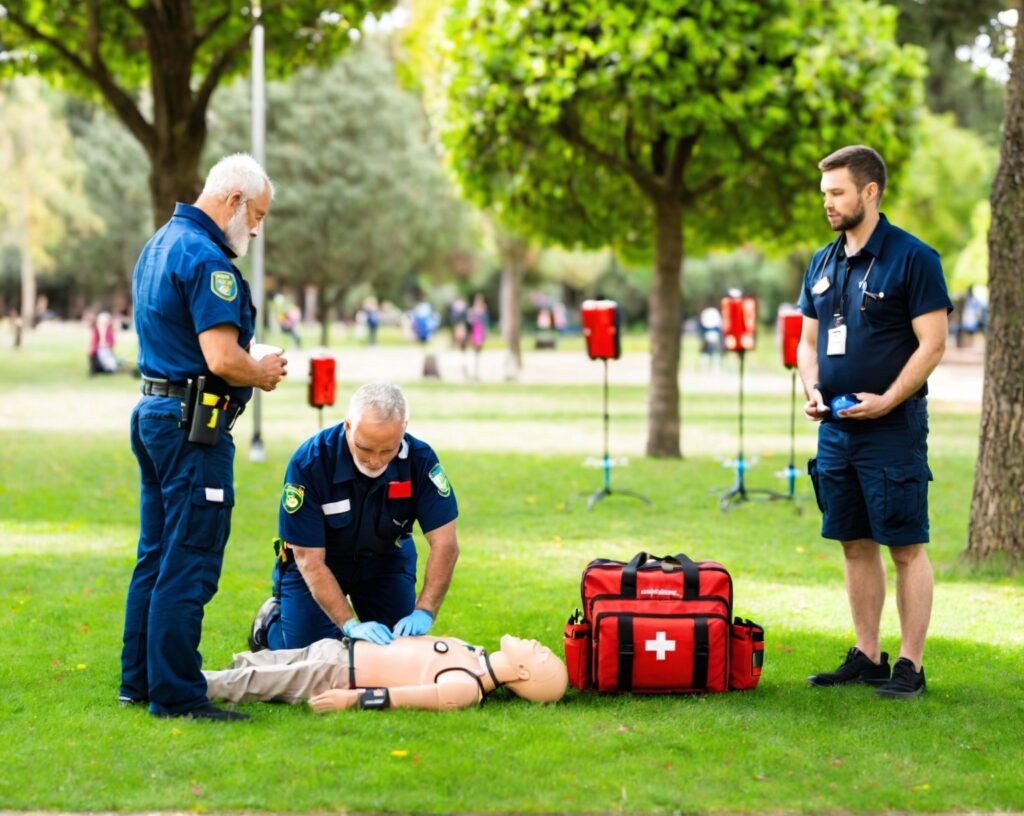Sudden cardiac arrests are a major health concern across the UK, striking without warning and requiring immediate action. The key to improving survival rates lies in the prompt use of Automated External Defibrillators (AEDs) and effective training. Recognising the signs of cardiac emergencies and knowing how to respond can dramatically increase the chances of survival. This article delves into the critical role of AED training in saving lives and how it can be made more accessible to the public.
Understanding Cardiac Emergencies
A cardiac arrest occurs when the heart suddenly stops beating, cutting off blood flow to the brain and other vital organs. Immediate response is crucial; each minute that passes without intervention reduces the chances of survival by 10%. Unfortunately, without quick action, the survival rates are grim. It’s vital everyone understands these emergencies can happen to anyone, anywhere, and knowing what to do can make all the difference.
Role of AEDs in Cardiac Response
AEDs are devices designed to deliver an electric shock to a heart experiencing cardiac arrest. This shock can potentially restore a normal heart rhythm. Having AEDs in public places increases the accessibility of lifesaving technology, enabling bystanders to act quickly during a cardiac emergency. The presence of these devices in public venues, like shopping centres, sports facilities and transport hubs, is a crucial step towards community safety.
Basic Steps of AED Operation
Using an AED may seem daunting, but it’s designed for simplicity so that even non-medical persons can use it effectively. Here are the basic steps: first, turn on the AED and follow the visual and audio prompts. Apply the electrode pads to the patient’s bare chest as instructed by the device.
Once the pads are in place, the AED will assess the heart’s rhythm and advise if a shock is needed. If so, ensure that no one is touching the patient and press the shock button when prompted. For ongoing support, consider online AED training courses, which provide detailed instructions and scenarios to help you become more confident in using an AED.
Who Can Use an AED?
In the UK, anyone can use an AED. You don’t need medical training to operate the device. Legal protections are in place to encourage bystander intervention, ensuring that helpers are not deterred by the fear of legal repercussions. This accessibility ensures that AEDs can be used by anyone present at the scene of a cardiac emergency, greatly increasing the chances of saving a life.
AED Placement and Availability
The strategic placement of AEDs can be lifesaving, making these devices as common as fire extinguishers. High-traffic areas such as gyms, schools and workplaces are ideal locations for AEDs. Ensuring these devices are visible and easily accessible can help facilitate a rapid response during an emergency, significantly improving outcomes in cardiac emergencies.
Incorporating AED Training in First Aid Courses
First aid courses that include AED training are essential for teaching the public how to respond in emergencies. These courses cover the basics of cardiopulmonary resuscitation (CPR) and AED use, empowering more people to act confidently and competently during critical situations. The knowledge gained from these courses prepares individuals not only to use AEDs but also to perform essential life-saving techniques until professional help arrives.
Certification in AED Training
Gaining certification in AED use can further boost an individual’s readiness to handle health crises. Certified training ensures that participants have met all the required learning objectives and are proficient in the techniques necessary to save lives.
Many elearning courses with certification offer comprehensive training that culminates with a certification, providing a formal acknowledgement of the skills learned. These certifications can be particularly valuable for workplaces, educational institutions and community centres looking to enhance their health and safety measures.
Impact of AED Training on Community Health Outcomes
Communities with widespread AED training see higher survival rates from sudden cardiac arrests. By educating the community and increasing the number of trained responders, these areas improve their overall safety and resilience. Case studies from around the UK show that areas with higher concentrations of trained individuals and publicly accessible AEDs have better emergency response outcomes.
Future of AED Training and Technology
The future of AED training looks promising, with technological advancements making training more accessible and AEDs more user-friendly. Innovations such as virtual reality simulations and advanced elearning platforms are enhancing the training experience, making it more interactive and engaging. These advancements are expected to spread even wider, integrating more seamlessly into everyday life and community health initiatives.
Understanding how to use an AED and becoming trained in its application are crucial steps toward saving lives in cardiac emergencies. With the availability of online aed training and elearning courses with certification, more individuals can become capable first responders, equipped to act in those critical first minutes of a cardiac emergency.
As AED technology and training methods continue to evolve, the hope is that more lives will be saved, and the notion of community health safety will be strengthened. Let’s embrace these opportunities to learn and prepare ourselves to make a difference when it matters most.

